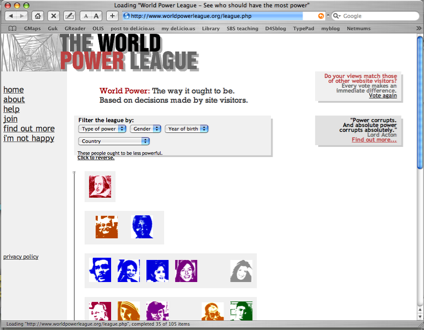How do young people understand different kinds of power?
The World Power League website draws on the successful website ‘Am I hot or not?’ to offer users a ‘throwaway interaction’. Site visitors are presented with a choice between two people and asked to click on the one who should be more powerful for example Nelson Mandela or the So Solid Crew. Visitors can repeat this several times, each time being presented with different people drawn from the database. Some of the people have formal political power, others are influential individuals or groups drawn from popular culture, sport, activism or business. The aggregated data from all users’ choices are presented visually in the world power league, which shows who users think should be powerful. In the schools version, pupils can add themselves to the database, building up a visual representation of power relations in a familiar context.
World Power League

Website
Collaboration with Barby Asante, Rachel Collinson and George Grinsted
Commissioned by NESTA Futurelab and subsequently further developed by them as ‘Power League’
Background
The World Power League is an online resource for teachers and young people aimed at stimulating discussion around power - who has it, by what means they have it, and the different kinds of power people can have. The idea was developed through a process initiated by Lucy Kimbell and Barby Asante, working with a class of year 10 pupils at Queens Park secondary school in London. The insights gathered from this were the springboard into a software development process in which software developer George Grinsted and graphic designer Rachel Collinson joined the team. The World Power League prototype was the result.
